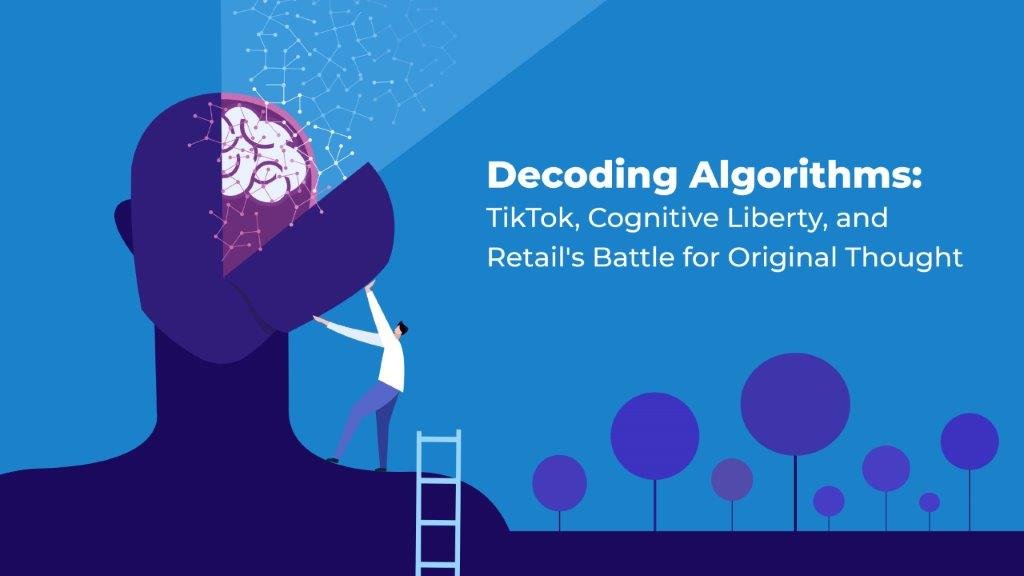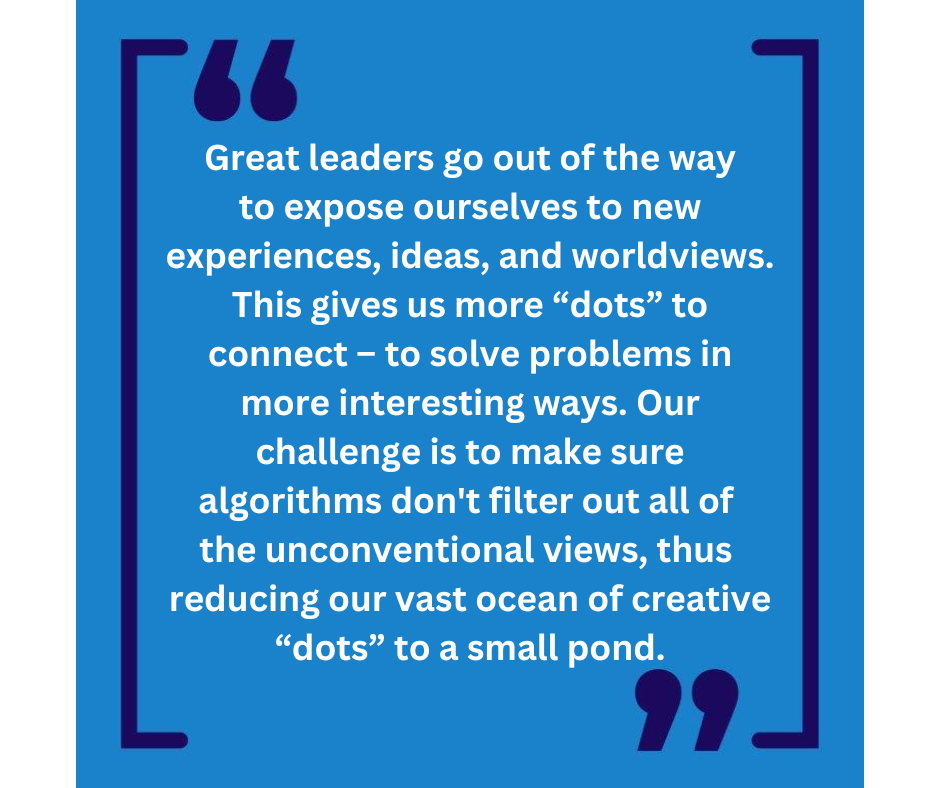Decoding Algorithms: TikTok, Cognitive Liberty, and Retail's Battle for Original Thought
A headline in Wired recently caught my attention: “TikTok is Letting People Shut Off Its Infamous Algorithm – and Think For Themselves.
That’s a provocative headline, and it nudged me to dig deeper into this topic. (Perhaps echoing a cultural moment reminiscent of 2008 when technologist Nicolas Carr asked, “Is Google Making Us Stupid?”)
We know that algorithms power an increasing number of our daily tasks, but are they somehow affecting our cognitive capacities in the process? How are algorithms shaping your brain?
When it comes to TikTok, the app’s engaging content-selection algorithm learns from users’ interactions to create highly tailored user experiences. In short, this means that Tik Tok uses everything you watch, like and share to expertly feed you more of the same.
This sounds efficient at first blush. There is more digital content in the world today than any human could ever sort through. Isn’t it beneficial if a finely tuned sequence of mathematical instructions can do the heavy lifting for us?
But amidst the efficiency, a growing number of technologists and tech enthusiasts are raising a question about the flip side of that coin: “What about all the things the app doesn’t show you?”
Are filtering algorithms like the ones Tik Tok uses shaping our mental states, feelings and preferences “without our full awareness or consent?”
Further, and most germane to my interests, what do we lose when we aren’t exposed to a diverse variety of content, ideas, and viewpoints? When we don’t, at least sometimes, interact with things we disagree with or even dislike?
The Cognitive Liberty Movement
To address these concerns that “filtering algorithms” (not to mention associated technologies like “generative AI”) may not be ALL upside, some technologists have begun championing the idea of “cognitive liberty,” which simply means the fundamental right to self-determination over our brains and mental experiences.
Thus, Tik Tok’s move to allow users in the EU to opt out of their powerful filtering algorithm and explore the wide world of Tik Tok content on their own terms.
I’m diving in to learn more about the idea of “cognitive liberty” and inviting my readers to come along for the journey. (This all sounds very The Matrix, doesn’t it?)
The movement reminds me of the concept of the retail filter bubble, something I wrote about a few years back.
Eli Paiser coined “filter bubble” back in 2011 to describe the intellectual isolation that occurs when algorithms selectively tailor everything we see to align with what we already believe. I explored the application of this to retail, writing back in 2017 that:
“It is troubling to imagine a world where shoppers almost exclusively browse and purchase items an algorithm has determined they will like. At best, that sounds boring and staid in a category and culture that values the novel and unique.
At worst, it could leave shoppers feeling dispassionate and uninspired. In a heavily filtered retail world, it is not a stretch to imagine retailers will see less brand and product diversity in shopper baskets, lower trial of new brands, and have fewer opportunities to surprise customers with an unexpectedly satisfying product….
If we worry that too much data will make the retail offering predictable and uninspired, what’s the solution? Retail Serendipity.
Fast forward to 2023. The data sets are even bigger, and the predictive algorithms are even better. Further, we have generative AI applications like Mindjourney and Chat GPT producing content that blurs the lines between human and AI creation, yet lacks human perspective.
Where From Here?
How to Champion Cognitive Liberty
For business leaders, it’s crucial to consider how the algorithms and generative AI content generators shape creativity and original thought. Great leaders go out of their way to expose ourselves to new experiences, ideas, and worldviews. This gives us more “dots” to connect – to solve problems in more interesting ways. Our challenge ahead is to make sure algorithms don't filter out unconventional viewpoints, thus reducing our vast ocean of creative dots to a small pond.
Within our organizations, we must also champion an emphasis on original thinking. This of course doesn’t mean forgoing the use of algorithms to help make sense of vast amounts of content and increase productivity in daily tasks. But it does mean identifying those parts of our value chain where we really need human creativity and innovation, and ensuring our teams can rise to the occasion.
We need to consider how to empower consumers, too, with a level of algorithmic understanding and control when it comes to interacting with our brands and the broader retail category. This means enabling choices and transparency, akin to something like what TikTok is trying in the UK.
Opportunities
For Your Brand
The list of companies using algorithms to show their consumers more of what they already know they will like is extensive. It includes Netflix, Amazon, Spotify, Apple, FlipBoard, Facebook and Instagram, GoodReads, Etsy, Alibaba, and Google, not to mention most digital retail ecosystems – just to name a few.
Yet those prioritizing cognitive liberty are rare; in research for this article, I came across scant articles devoted to this topic. One standout includes the content-summarizer company Blinkist. In the podcast “The Art of Curation,” their Director of Content Discovery Robyn Kerkhof does a great job of explaining how expert human curation adds to the bottom line, by creating moments of “aha” or “epiphany” for consumers that cannot be delivered by machine learning alone.
In the short term, I see an opportunity for retail brands to incorporate features like these into their digital offerings to create those “aha” moments:
1) Human-Led Curation: Employing subject matter experts to assemble and showcase unexpected finds and discoveries.
2) Chronological Sorting: Allowing consumersto sort digital content in time order instead of algorithmically. This approach can be particularly useful for platforms that curate content feeds, ensuring that customers see broader content beyond what expressly aligns with their last view.
3) User-Generated Recommendations: Creating or showcasing features that enable customers to receive recommendations based on other users' input, as opposed to algorithmic predictions. This way, customers can enjoy the collective wisdom of the community, leaving room for unexpected content along the way.
4) Algorithm-Free Parts of Your Ecosystem: Creating dedicated sections within your brand’s ecosystem that are clearly labeled as algorithm free. Customers can explore products or content in these sections without any algorithmic influence, leaving cognitive liberty room to flourish.
Additionally, a few other platforms similar to Blinkist are pointing the way, aiming to diversify their content by incorporating more human curation and community-driven recommendations.
>> Curated newsletters like The Browser, whose editorial team reads hundreds of articles daily and sends five recommended stories for the day “so you’ll always have interesting things to ponder and fascinating ideas to discuss at dinner.”
>> DuckDuckGo, a browser and search engine that does not track online activity, meaning that new searches will not be filtered and tailored based on previous search history. This is one way to end the filter bubble feedback loop and gain new points of view in your online searches.
>> LongReads provides reader-funded access to the world’s best storytelling. The platform curates content based on editors’ selections alone, providing a space to discover well-written articles outside of what your algorithms might serve you.
>> Subreddits on Reddit often share recommendations, and you can ask for suggestions within specific interest areas, creating a more community-driven approach to book recommendations.
In an era saturated with algorithmic interventions, prioritizing cognitive liberty is essential for every retail leader. Scientist Thomas Kuhn's words resonate: "Discovery commences with anomaly." How will we get to the anomalies if we are all using the same bodies of language and perusing content eerily like what is being generated by our competitors?
It's a defining question for the AI age, one we can only answer by navigating the uncharted waters of original thought.





